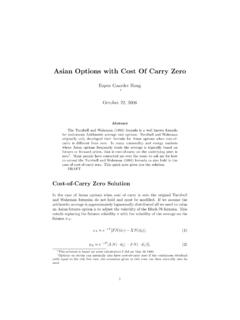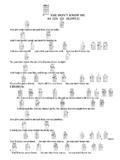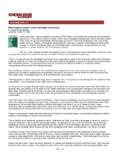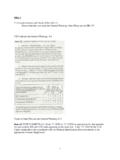Transcription of THE COLLECTOR: Know Your Weapon Part 1 T
1 Wilmottmagazine49ing millions of dollars -can only be learnedthrough real action. Now, the manual:BSD trader Solider, welcome to our tradingteam, this is your first day and I will instructyou about the Black-Scholes Weapon . New hired Trader Hah, my Professortaught me probability theory, It calculus,and Malliavin calculus! I know everythingabout stochastic calculus and how to comeup with the Black-Scholes formula. BSD trader Solider, you may know how toconstruct it, but that doesn t mean you knowa shit about how it operates! New hired Trader I have used it for real trad-ing. Before my I was a market maker instock options for a year. Besides, why do you callme solider? I was hired as an option trader. BSD trader Solider, you have not been inreal war. In real war you often end up inextreme situations.
2 That s when you need toknow your Weapon . New hired Trader I have read Liar s Poker,Hull s book, Wilmott on Wilmott, Taleb sDynamic Hedging, Haug s formula collec-tion. I know about Delta Bleed and all thatstuff. I don t think you can tell me muchmore. I have even read Fooled by Ran .. BSD trader SHUT UP SOLIDER! If you wantto survive the first six months on this tradingfloor you better listen to me. On this team wedon t allow any mistakes. We are warriors,trained in war! New hired Trader Yes Sir! BSD trader Good, let s move on to our busi-ness. today I will teach you the basics of theBlack-Scholes Weapon . 1 Background on the BSM formulaLet me shortly refresh your memory of the BSMformulac=Se(b r)TN(d1) Xe rTN(d2)p=Xe rTN( d2) Se(b r)TN( d1),whered1=ln(S/X)+(b+ 2/2)T T,d2=d1 T,andS=Stock price of interest rate of holding the to expiration in options is War!
3 For anoption trader a pricing or hedgingformula is just like a Weapon . Asolider who has perfected her pis-tol shooting1can beat a guy with amachine gun that doesn t knowhow to handle it. Similarly, an option traderknowing the ins and outs of the Black-Scholes-Merton (BSM) formula can beat a trader using astate-of-the-art stochastic volatility model. Itcomes down to two rules, just as in war. Rulenumber one: know your Weapon . Rule numbertwo: Don t forget rule number one. In my ten+year as a trader I have seen many a BSD2optiontrader getting confused with what the computerwas spitting out. They often thought somethingwas wrong with their computer system/imple-mentation. Nothing was wrong, however, excepttheir knowledge of their Weapon . Before youmove on to a more complex Weapon (like a sto-chastic volatility model) you should make sureyou know conventional equipment inside-out.
4 Inthis installment I will not show the nerdy quantshow to come up with the BSM formula using somenew fancy mathematics you don t need to knowhow to melt metal to use a gun. Neither is it aguideline on how to trade. It is meant rather likea short manual of how your Weapon works inextreme situations. Real war (trading) -the pain,the pleasure, the adrenaline of winning and loos-THE COLLECTOR: To this article I got a lot of ideas from the Wilmott forum. Thanks! And especially thanks to J rgen Haug and James Ward for useful comments on this paper. know your WeaponPart 1^Espen Gaarder HaugESPEN GAARDER HAUG50 Wilmottmagazine =Volatility of the relative price changeof the underlying stock (x)=The cumulative normal Delta DeltaAs you know , the delta is the option s sensitivityto small movements in the underlying assetprice.
5 Call= c S=e(b r)TN(d1)>0 put= p S= e(b r)TN( d1)<0 Delta higher than unityI have many times overthe years been contacted by confused commodi-ty traders claiming something is wrong withtheir BSM implementation. What they observedwas a spot delta higher than we get deep-in-the-money N(d1)approach-es one, but it never gets higher than one (sinceit s a cumulative probability function). For aEuropean call option on a non-dividend-payingstock the delta is equal to N(d1), so the delta cannever go higher than one. For other options thedelta term will be multiplied by e(b r)T. If thisterm is larger than one and we are deep-in-the-money we can get deltas considerable higherthan one. This occurs if the cost-of-carry is largerthan the interest rate, or if interest rates are neg-ative.
6 Figure 1 illustrates the delta of a calloption. As expected the delta reaches aboveunity when time to maturity is large and theoption is Delta mirror strikes and assetFor a put and call to have the same absolute deltavalue we can find the delta symmetric strikes asXp=S2 Xce(2b+ 2)T,Xc=S2 Xpe(2b+ 2) is c(S,Xc,T,r,b, )= p(S,S2 Xce(2b+ 2)T,T,r,b, ).where Xcis the strike of the call and Xpis thestrike of a put. These relationships are useful todetermine strikes for delta neutral option strate-gies, especially for strangles, straddles, and but-terflies. The weakness of this approach is that itworks only for a symmetric volatility smile. Inpractice, however, you often only need an approx-imately delta neutral strangle. Moreover, volatili-ty smiles often are more or less symmetric in thecurrency the special case of a straddle-symmetric-delta-strike, described by Wystrup (1999), the for-mulas above can be simplified further toXc=Xp=Se(b+ 2/2) to this relationship is the straddle-symmetric-asset-price.
7 Given the identical strikesfor a put and call, for what asset price will theyhave the same absolute delta value? The answer isS=Xe( b 2/2) this strike and delta-symmetric-asset-price thedelta is e(b r)T2for a call, and e(b r)T2for a put. Onlyfor options on non-dividend paying stocks3(b=r)can we simultaneously have an absolute delta (50%) for a put and a call. Interestingly, thedelta symmetric strike also is the strike given theasset price where the gamma and vega are at theirmaximums, ceteris paribus. The maximal gammaand vega,4as well as the delta neutral strikes, arenot at-the-money forward as I have noticedassumed by many traders. Moreover, an in-the-money put can naturally have absolute deltalower than 50% while an out-of-the-money callcan have delta higher than 50%.
8 For an option that is at the straddle-symmetric-delta-strike the generalized BSM formula can besimplified toc=Se(b r)T2 Xe rTN( T),andp=Xe rTN( T) Se(b r) this point the option value will not changebased on changes in cost of carry (dividend yieldetc). This is as expected as we have to adjust thestrike to maturityAsset priceX = 100, r = 5%, b = 30%, = 25%, Figure DeltaWilmottmagazine51^ Strike from deltaIn several OTC (over-the-counter) markets optionsare quoted by delta rather than strike. This is acommon quotation method in, for example, theOTC currency options market, where one typicallyasks for a delta and expects the sales person toreturn a price (in terms of volatility or pips) as wellas the strike, given a spot reference. In these casesone needs to find the strike that corresponds to agiven delta.
9 Several option software systems solvesthis numerically using Newton-Raphson or bisec-tion. This is actually not necessary, however. Usingan inverted cumulative normal distribution N 1( )the strike can be derived from the delta analytical-ly as described by Wystrup (1999). For a call optionXc=Sexp[ N 1( ce(r b)T) T+(b+ 2/2)T],and for a put we haveXp=Sexp[N 1( pe(r b)T) T+(b+ 2/2)T].To get a robust and accurate implementation ofthis formula it is necessary to use an accurateapproximation of the inverse cumulative nor-mal distribution. I have used the algorithm ofMoro (1995) with good DdeltaDvol and DvegaDvolDdeltaDvol: which mathematically is thesame as DvegaDspot: vega S, Vanna,5showsapproximately how much your delta will changefor a small change in the volatility, as well ashow much your vega will change with a smallchange in the asset price:DdeltaDvol= c S = p S = e(b r)Td2 n(d1),where n(x)is the standard normal densityn(x)=1 2 e x2 fine day in the dealing room my risk manag-er asked me to get into his office.
10 He asked mewhy I had a big outright position in some stockindex futures -I was supposed to do arbitragetrading . That was strange as I believed I was deltaneutral: long call options hedged with shortindex futures. I knew the options I had were farout-of-the-money and that their DdeltaDvol wasvery high. So I immediately asked what volatili-ty the risk management used to calculate theirdelta. As expected, the volatility in the risk-man-agement-system was considerable below the mar-ket and again was leading to a very low delta forthe options. This example is just to illustrate howa feeling of your DdeltaDvol can be useful. If youhave a high DdeltaDvol the volatility you use tocompute your deltas becomes very 2 illustrates the DdeltaDvol. As we cansee the DdeltaDvol can assume positive and neg-ative values.







